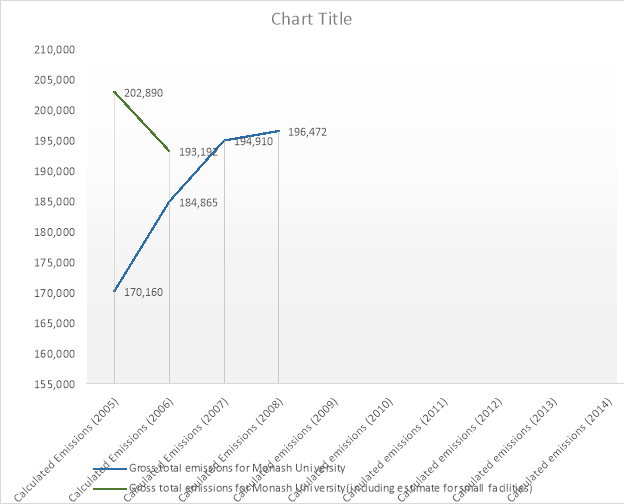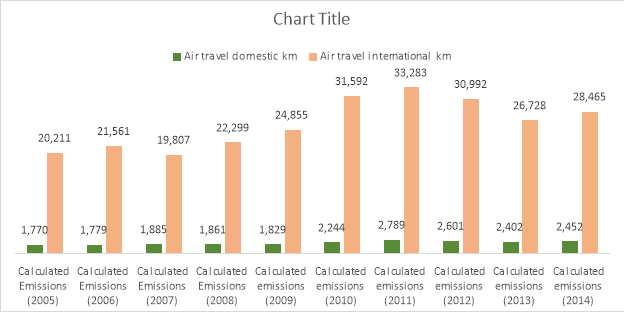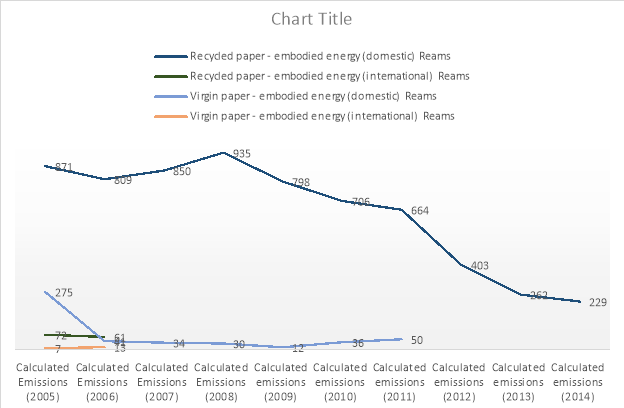Monash Carbon Footprint report
This report presents interpreted data after Monash university conducted a carbon footprint assessment between 2005 till 2014.
Introduction
Today we can see for ourselves the damage we have caused to our home planet. overshoot is known as the consumers demands for earths resources are going beyond the level which the earth can regenerate. According to dahl(2008), “improving global governance and our ability to manage the earths resources is thus a key part of any solution. Preventing overshoot and collapse is a challenge of our time”. to reduce greenhouse gas emissions, Monash university has assessed their carbon footprint from 2005 to 2014. Monash university consists of the Berwick, Caulfield, Clayton, Parkville, and Peninsula campuses within all of Australia, Carbon dioxide(co2) is emitted daily when we account for the burning of fossil fuels to supply heat and to cool rooms, to run appliances, transportation, and the management of water and waste products. According to the united states environmental protection agency, co2 is then trapped within our earth’s atmosphere and are termed as greenhouse gases as co2 is a direct threat to our ozone layer and is also a major contributor to global warming. There are three scopes consisting of either direct or indirect. Monash university’s gross total emissions started out with 168,838 tonnes of co2-e/year after being recorded in 2005 and at the end of 2014, Monash university’s gross total emissions were calculated at 190,874 tonnes of c02-e/year.
Characterizing the scopes
Scope 1: this is a direct method of emitting greenhouse gases (GHG) by Monash university’s use of natural gas at all sites, the types of fuel used for transportation, the types of fuel used for other purposes, use of appliances such as refrigerants, methane emissions, and commercial c02.
Scope 2: this is an indirect consequence by monash university of GHG emissions released for their use of electricity which is purchased from another party.
Scope 3: this is also an indirect way of GHG emissions being released into the earth’s atmosphere which generally accounts for electricity, natural gas, paper/cardboard waste, food waste, recyclables, transport fuel, water waste, air travel, taxi cabs, fire extinguishers, and public transport.
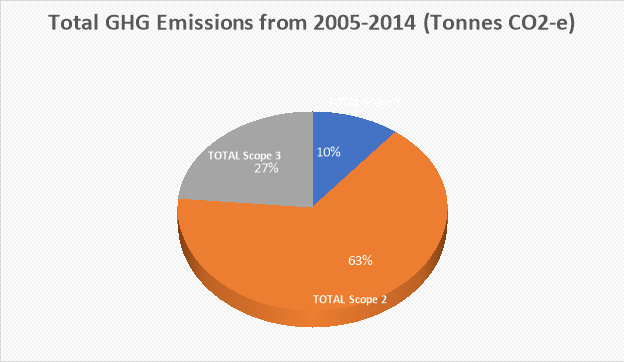
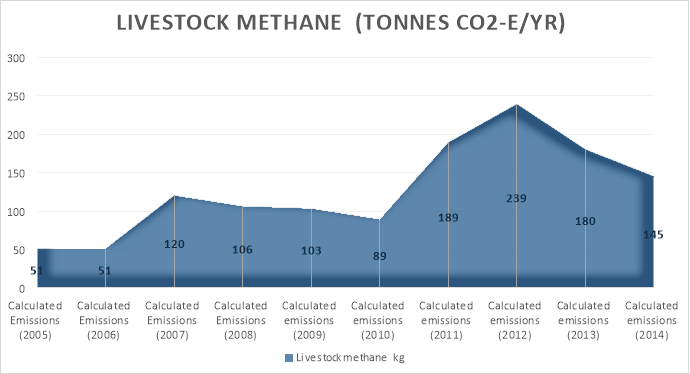 GHG emissions from scope 1
GHG emissions from scope 1
according to marty mccarthy (2015), scientists gathered a national study was taken where over a 1000 cows were tested and the method of measuring the ghg emissions under the factor of livestock methane is by putting the livestock animal in chamber which can be used to measure methane. Then the next step is to monitor the air in and out and then calculate the concentration in that of the air mixture. It can be observed that the emissions have tripled over the course of 9 years. A reason to this might be the amount of food that is been fed to the livestock animal, or ….
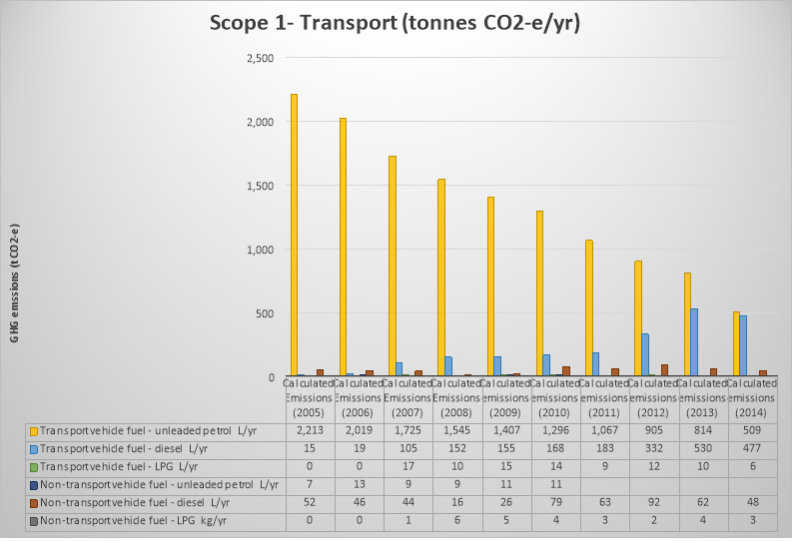 upon checking the ghg emissions within all of the sites of monash university, it is most important to check the fuels used for transport purposes and to separate the types of fuel since different fuels produce different emiisions. according to the national greenhouse account factors (2014), there is a formula which calculates the ghg emisiions released by different fuel types. there is a trend to be seen and it could be seen that the ghg emissions are slowing declining after each year. A reason to this might be the adaptation of hybrids and electric cars… the ghg emissions can be measure by the equation given below,
upon checking the ghg emissions within all of the sites of monash university, it is most important to check the fuels used for transport purposes and to separate the types of fuel since different fuels produce different emiisions. according to the national greenhouse account factors (2014), there is a formula which calculates the ghg emisiions released by different fuel types. there is a trend to be seen and it could be seen that the ghg emissions are slowing declining after each year. A reason to this might be the adaptation of hybrids and electric cars… the ghg emissions can be measure by the equation given below,
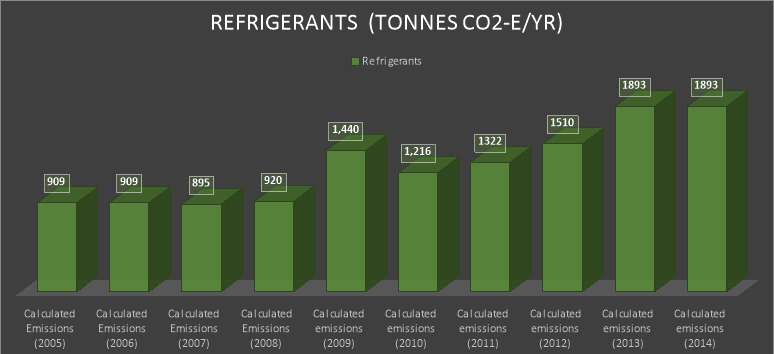
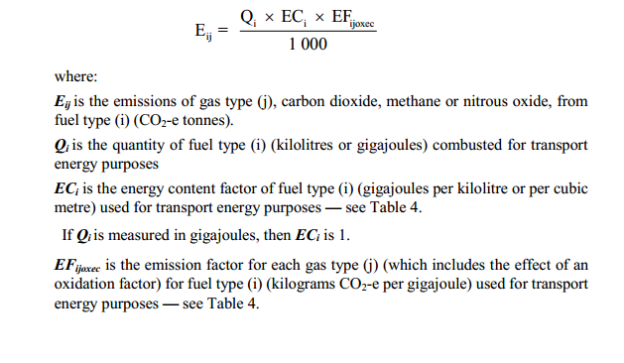
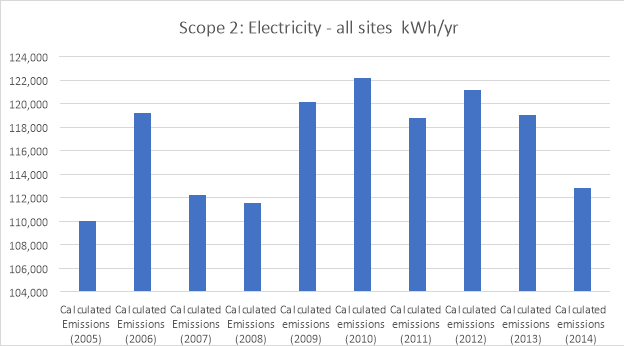
scope 1 – Refrigerants
When we use refrigerants, we never account for the harmful emissions that are released into our atmosphere. Beck in the day, ghg emissions like chlourofluoro carbons(CFC), halons, and hydrochlorofluro carbons (HCFC) went unnoticed for a very long time. To combat CFCs , halons, HCFCs, substitues such as hydroflouro carbons (HFC) and perfluoro carbons (PFC) have been used to regulate the substances that deplete the ozone layer. This occurance was due to the amendment of the montreal protocol in 1990 which is known to be widely successful due to the universal ratification of fighting ozone depleting substances (ODS). Emissions from regrigerators and ari conditioners can be a resulted from the manufacturing process of the product, from leakages, or from poor service of the operation life of the products. Any reduction of the ODSs can have huge potential benefits since ODSs pose a threat greater than 1000 times that of co2. during the period of assessing monsh univeritisy’s carbon footprint, it can be see that there is a linear trend where ghg emissions are increasing over time. This can be a result of opening up new builings within the campuses and the addition of commercial unitary air contioning units to have comfortable room temperatures in the given buildings, or it can be from the transport of refrigerated goods, ….
Scope 2 – electricity
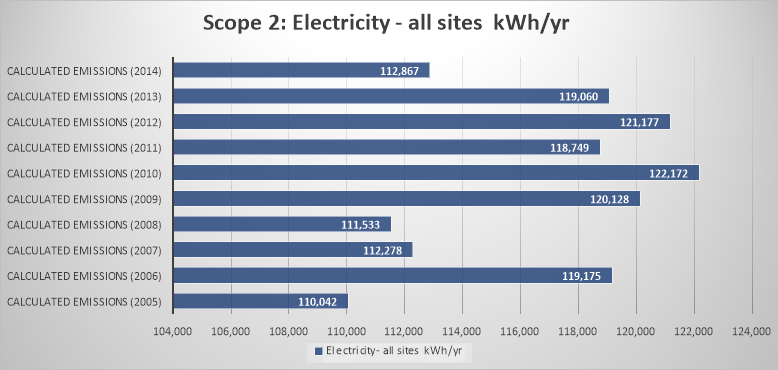
The ghg emissions from the comsumption of purchased electricity from the grid has a physically toll on our environment but this is not a direct result from monash university as aforementioned. The burning and processing of coal, natural gas, or the refinement and transport of crude oil(petroleum) can have the direct response of ghg emission released into our environment. Emissions from electricity (scope 2) can be meure by the equation below,
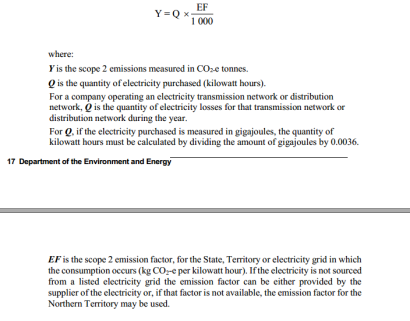
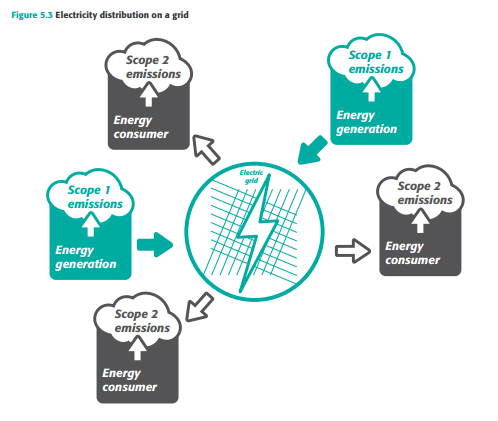
According to scope 2 guidance by GHG protocol, there are two methods to determine for the emission associated with electricity consumption. The first metheod is the location-based method, where it can be applied to every grid, and it focues on the connection between collective comsumer demand for electricity and how much emisiions re leased from the local electricity generated. The other method which is market-based method, focuses on hoiw much electricity is consumed by the choices of the consumer. Observing Monash Univeristy’s scope 2 emissions, is can be seen in the graph that the lowest reading of GHG emissions occurred in 2005, and throughout the years of recording scope 2 emissions, it can be seen the number fluctuates each year till the period of 2009 till 2014 where the number have a staggering amount where the ghg emissions ranges around 120, 000 tonnes of CO2-e per year, but during 2014, the ghg emissions have sort of been regulated. A reason for the increase of ghg emissions might be negotiating with a company whose primary source of energy might be from coal, and a way to reduce this would be to switch to a low carbon electricity supplier, or to purchase certifictaes from low carbon energy generation.
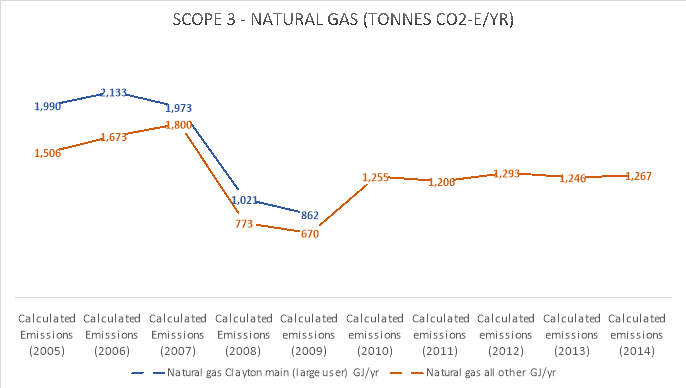 Scope 3
Scope 3
vhbj
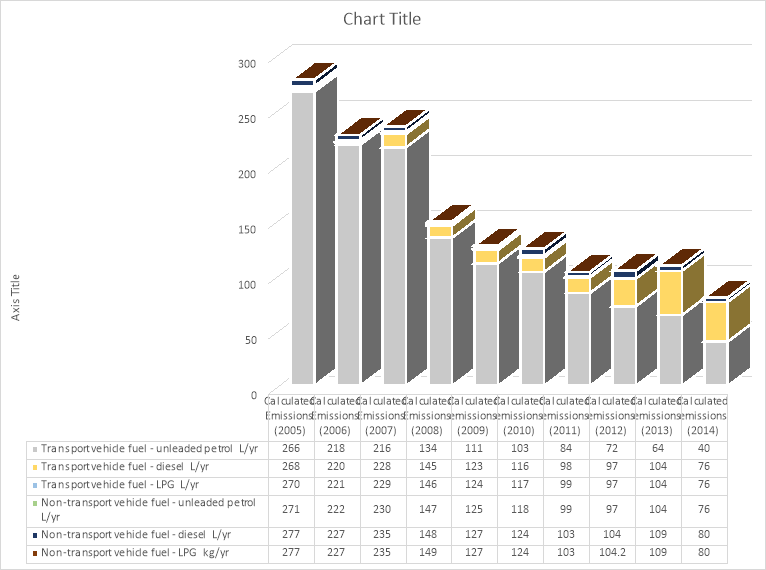
Bjbjbjbj
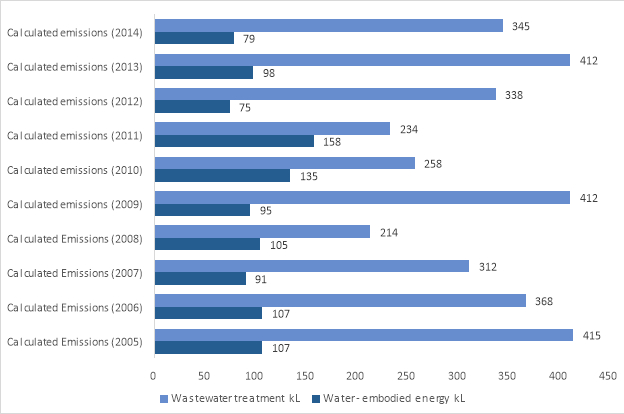
Bssssssssssssssssssssssssssssssssssssssssssssssssssssssssssssssssssssssssssssssssssssssssssssssssssssssssssssssssssssssssssssssssssssssssssssssssssssssssssssssssssssssssssssssnjvbgrjgbrjebgerjbjrbgrjbrjbgjrbgrbjrbjr https://www.giss.nasa.gov/research/briefs/fung_01/
http://www.abc.net.au/news/2015-12-14/impact-of-cattle-on-methane-emissions-downgraded/7027088
http://www.chlorinated-solvents.eu/index.php/regulatory-compliance/ods-regulation
http://www.environment.gov.au/protection/ozone/montreal-protocol
http://ghgprotocol.org/files/ghgp/Scope%202%20Guidance_Final.pdf
http://www.cleanenergyregulator.gov.au/NGER/About-the-National-Greenhouse-and-Energy-Reporting-scheme/Greenhouse-gases-and-energy
http://www.cleanenergyregulator.gov.au/DocumentAssets/Documents/NGER%20Energy%20production%20and%20consumption.pdf
http://www.environment.gov.au/climate-change/greenhouse-gas-measurement/publications/national-greenhouse-accounts-factors-dec-2014
https://www.monash.edu/environmental-sustainability/get-involved/staff/green-program
https://www.monash.edu/environmental-sustainability/get-involved/students/do-one-thing
https://www.monash.edu/environmental-sustainability/campus-initiative/energy/renewable-energy
http://www.greenpower.gov.au/About-Us/
https://www.epa.gov/ghgemissions/overview-greenhouse-gases
http://edition.cnn.com/2016/07/01/health/antarctic-ozone-layer-healing/
http://sciencing.com/co2-deplete-ozone-layer-4828.html
http://www.cleanenergyregulator.gov.au/NGER/About-the-National-Greenhouse-and-Energy-Reporting-scheme/Greenhouse-gases-and-energy
http://www.ghgprotocol.org/calculation-tools/faq
http://www.environment.gov.au/climate-change/greenhouse-gas-measurement/publications/nger-technical-guidelines-2014
http://www.ghgonline.org/othershfcs.htm
https://ec.europa.eu/clima/policies/f-gas/alternatives_en
https://www.epa.gov/ods-phaseout
http://www.energyaction.com.au/energy-procurement/electricity-procurement
http://www.ghgprotocol.org/scope_2_guidance
http://www.treasury.gov.au/PublicationsAndMedia/Publications/2015/2015-Intergenerational-Report
http://www.treasury.gov.au/~/media/Treasury/Publications%20and%20Media/Publications/2015/2015%20Intergenerational%20Report/Downloads/PDF/2015_IGR.ashx
https://www.mla.com.au/Research-and-development/Environment-sustainability/National-livestock-methane-program
https://www.monash.edu/environmental-sustainability/our-commitment/environmental-sustainability-policy
https://www.monash.edu/policy-bank/management/facilities-services/enviro-procedures
http://iefworld.org/ddahl08d.htm
https://www.monash.edu/__data/assets/pdf_file/0005/783617/Environmental-Sustainability-Policy-Australia-only.pdf
https://phys.org/news/2007-11-atmosphere-carbon.html
http://www.environment.gov.au/climate-change/greenhouse-gas-measurement/tracking-emissions
http://www.environment.gov.au/system/files/resources/da7bde5c-1be2-43f7-97d7-d7d85bb9ad6c/files/nger-technical-guidelines-2014.pdf
http://www.environment.gov.au/system/files/resources/5e11ecad-6d23-4e4b-bf9d-d4630a4e523b/files/nger-technical-guidelines-2012.pdf
https://carbonneutral.com.au/wp-content/uploads/2015/01/Carbon-Offsetting-and-Carbon-Neutralilty-Explained.pdf
https://www.epa.gov/sites/production/files/2015-07/documents/fugitiveemissions.pdf
http://www.treasury.gov.au/~/media/Treasury/Publications%20and%20Media/Publications/2015/2015%20Intergenerational%20Report/Downloads/PDF/2015_IGR.ashx
gbrjbgrjgbrjbgrjbgjrbgjjj